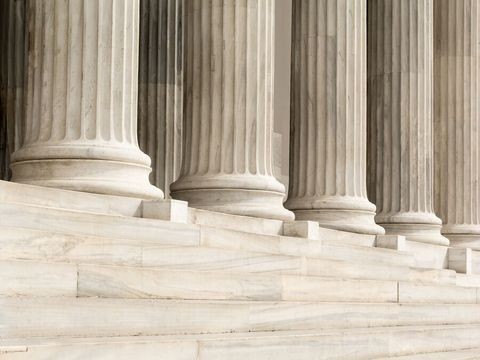NCAA v. Alston Signals Peril for the NCAA’s Amateurism Defense But Implications for Antitrust Go Well-Beyond Collegiate Sports
Client Alert | 5 min read | 06.23.21
On Monday, the Supreme Court dealt a unanimous blow to the NCAA in NCAA v. Alston, 594 U. S. ____ (2021). The Court not only ruled against the NCAA on the issue of whether it can ban member schools from providing certain education-related benefits to their players, but it also invited challenges to the NCAA’s ban on other forms of athlete compensation. The decision capped years of litigation regarding the NCAA’s rules restricting various forms of such compensation and is likely to influence the course of those rules for years to come. As the Court’s most recent examination of the Sherman Act, however, the decision has broader implications. It will influence antitrust litigation more generally and includes discussions that will be touted by antitrust plaintiffs and defendants alike.
The plaintiffs are three classes of Football Bowl Subdivision and Division 1 basketball players who challenged the NCAA ban on compensation from member schools. At trial, the NCAA did not meaningfully dispute that it imposes compensation bans, that it has the power to set athletes’ wages, or that it has exercised this power in ways that produce anticompetitive effects. It rested its case solely on the defense that limiting athlete compensation is essential to maintain the “amateur” character of its product, collegiate sports. The district court held that the NCAA may limit compensation for athletic performance (essentially, salaries) but not “education-related benefits,” such as scholarships for graduate school. The Ninth Circuit affirmed the district court in full, the NCAA appealed, and the Supreme Court unanimously affirmed.
Time and again, the NCAA has defended its compensation limits by arguing that amateurism is essential to consumer demand for college sports because amateurism is what differentiates college from professional sports. The district court decision did not conceptually undermine this defense. Instead, the district court allowed limits to compensation for athletic performance and forbade limits on education-related benefits because it concluded that amateurism is served by the former but not the latter. The Supreme Court did not further upend the amateurism defense because plaintiffs did not challenge the district court’s approval of the NCAA’s limitation on compensation for athletic performance. But the Court invited future challenges to the amateurism defense, warning that a party cannot “relabel a restraint as a product feature and declare it immune” from antitrust laws. In a blistering concurrence, Justice Kavanaugh took the view a step further, writing that the remaining NCAA rules preventing compensation “raise serious questions under the antitrust laws,” explaining: “Nowhere else in America can businesses get away with agreeing not to pay their workers a fair market rate on the theory that their product is defined by not paying their workers a fair market rate. . . . The NCAA is not above the law.”
Beyond the NCAA, however, the case will likely become the go-to decision for framing the Sherman Act’s rule of reason. As it did in its 2018 decision in Ohio v. American Express, the Court indicated that rule of reason analysis should proceed in three steps, cementing this structured approach in law and the respective burdens it assigns to plaintiffs and defendants. But it also expanded the “quick look” rule of reason in a way that favors antitrust defendants. In past cases, such as NCAA v. Board of Regents of University of Oklahoma, 468 U. S. 85 (1984), the Court had only approved of a “quick look” to condemn certain restraints that are too competitively complex to be evaluated under the per se doctrine, but which nevertheless did not warrant a full rule of reason analysis. Here, although it rejected the NCAA’s argument that it should have benefited from it, the Court recognized for the first time that restraints can also be exonerated with a “quick look.” The Court explained, for example, that agreements which are needed to produce a sports league – such as the number of players and the time of play, but not wages – could pass muster with a quick look, providing an especially powerful tool to joint venture participants.
Reflecting its continued emphasis on false positives as a concern in antitrust enforcement, the Court also generally warned against “mistaken condemnations of legitimate business arrangements.” In support, the Court cited Verizon Communications Inc. v. Law Offices of Curtis V. Trinko, LLP, 540 U. S. 398, 414 (2004), without noting that its concern for mistaken condemnations there was focused on unilateral conduct. This distinction is critical because the Court has also recognized that because unilateral conduct is more likely to be the product of “competitive enthusiasm” than concerted conduct, more leeway must be given to unilateral conduct. Copperweld Corp. v. Indep. Tube Corp., 467 U.S. 752, 775 (1984). The Court’s silent extension of Trinko’s warning to Sherman Act § 1cases may also provide antitrust defendants with a valuable new shield.
The Court also signaled that precedent may be flexible in antitrust cases to reflect industry changes over time. The NCAA relied in part on the Court’s 1984 NCAA case in which the Supreme Court stated that “the preservation of the student-athlete in higher education . . . is entirely consistent with the goals of the Sherman Act.” After dismissing the comment as dicta, the Court added that the analysis of whether conduct is an antitrust violation may change as “market realities” change. The Court concluded that market realities had changed, pointing in part to the astronomical increase in revenue associated with the NCAA’s sports programs without explaining how changes in revenue are relevant to the antitrust analysis. The Court did not provide any guidance, however, as to when changed “market realities” furnish a hall pass from caselaw.
Although Alston handed the plaintiffs a rare unanimous victory, its impact will likely influence the application of the Sherman Act going forward in a variety of ways, especially in the context of joint ventures. The NCAA largely conceded the critical evidence regarding market power and harm to competition, limiting the direct precedential value of the decision. But the Court’s framing of the rule of reason, including its view that a quick look can be symmetrically applied, as well as its many cautionary statements about the care that lower courts must take in applying the antitrust laws and in fashioning remedies will be cited frequently by antitrust defendants. Finally, as public opinion shifts towards increasingly aggressive antitrust enforcement, public or private plaintiffs may cite Alston to argue that “market realities” justify departures from past caselaw. Of course, antitrust defendants are free to point to changed “market realities” as well.
Contacts
Insights
Client Alert | 5 min read | 12.12.25
Eleventh Circuit Hears Argument on False Claims Act Qui Tam Constitutionality
On the morning of December 12, 2025, the Eleventh Circuit heard argument in United States ex rel. Zafirov v. Florida Medical Associates, LLC, et al., No. 24-13581 (11th Cir. 2025). This case concerns the constitutionality of the False Claims Act (FCA) qui tam provisions and a groundbreaking September 2024 opinion in which the United States District Court for the Middle District of Florida held that the FCA’s qui tam provisions were unconstitutional under Article II. See United States ex rel. Zafirov v. Fla. Med. Assocs., LLC, 751 F. Supp. 3d 1293 (M.D. Fla. 2024). That decision, penned by District Judge Kathryn Kimball Mizelle, was the first success story for a legal theory that has been gaining steam ever since Justices Thomas, Barrett, and Kavanaugh indicated they would be willing to consider arguments about the constitutionality of the qui tam provisions in U.S. ex rel. Polansky v. Exec. Health Res., 599 U.S. 419 (2023). In her opinion, Judge Mizelle held (1) qui tam relators are officers of the U.S. who must be appointed under the Appointments Clause; and (2) historical practice treating qui tam and similar relators as less than “officers” for constitutional purposes was not enough to save the qui tam provisions from the fundamental Article II infirmity the court identified. That ruling was appealed and, after full briefing, including by the government and a bevy of amici, the litigants stepped up to the plate this morning for oral argument.
Client Alert | 8 min read | 12.11.25
Director Squires Revamps the Workings of the U.S. Patent Office
Client Alert | 8 min read | 12.10.25
Creativity You Can Use: CJEU Clarifies Copyright for Applied Art
Client Alert | 4 min read | 12.10.25
Federal Court Strikes Down Interior Order Suspending Wind Energy Development




